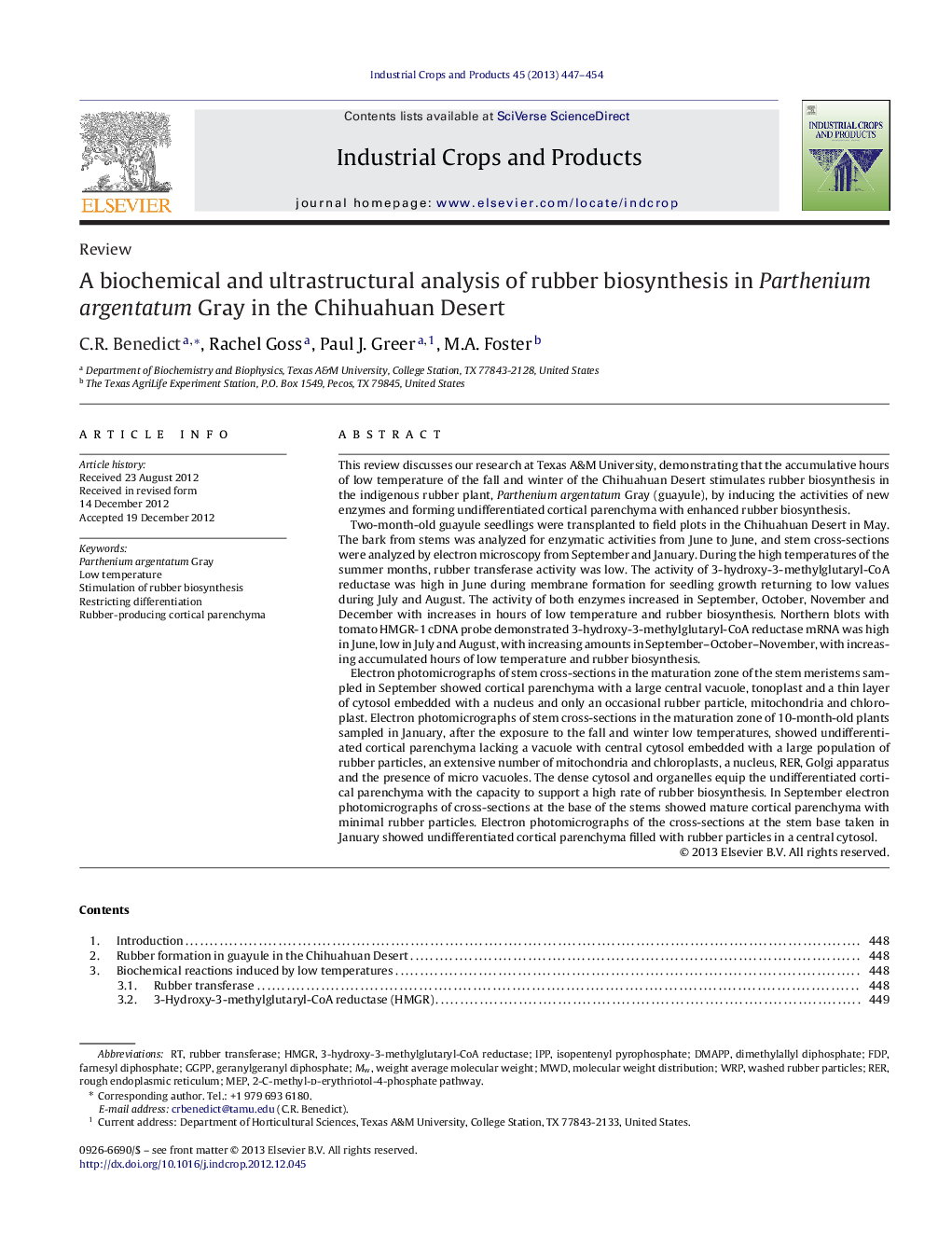| کد مقاله | کد نشریه | سال انتشار | مقاله انگلیسی | نسخه تمام متن |
|---|---|---|---|---|
| 4514073 | 1624864 | 2013 | 8 صفحه PDF | دانلود رایگان |

This review discusses our research at Texas A&M University, demonstrating that the accumulative hours of low temperature of the fall and winter of the Chihuahuan Desert stimulates rubber biosynthesis in the indigenous rubber plant, Parthenium argentatum Gray (guayule), by inducing the activities of new enzymes and forming undifferentiated cortical parenchyma with enhanced rubber biosynthesis.Two-month-old guayule seedlings were transplanted to field plots in the Chihuahuan Desert in May. The bark from stems was analyzed for enzymatic activities from June to June, and stem cross-sections were analyzed by electron microscopy from September and January. During the high temperatures of the summer months, rubber transferase activity was low. The activity of 3-hydroxy-3-methylglutaryl-CoA reductase was high in June during membrane formation for seedling growth returning to low values during July and August. The activity of both enzymes increased in September, October, November and December with increases in hours of low temperature and rubber biosynthesis. Northern blots with tomato HMGR-1 cDNA probe demonstrated 3-hydroxy-3-methylglutaryl-CoA reductase mRNA was high in June, low in July and August, with increasing amounts in September–October–November, with increasing accumulated hours of low temperature and rubber biosynthesis.Electron photomicrographs of stem cross-sections in the maturation zone of the stem meristems sampled in September showed cortical parenchyma with a large central vacuole, tonoplast and a thin layer of cytosol embedded with a nucleus and only an occasional rubber particle, mitochondria and chloroplast. Electron photomicrographs of stem cross-sections in the maturation zone of 10-month-old plants sampled in January, after the exposure to the fall and winter low temperatures, showed undifferentiated cortical parenchyma lacking a vacuole with central cytosol embedded with a large population of rubber particles, an extensive number of mitochondria and chloroplasts, a nucleus, RER, Golgi apparatus and the presence of micro vacuoles. The dense cytosol and organelles equip the undifferentiated cortical parenchyma with the capacity to support a high rate of rubber biosynthesis. In September electron photomicrographs of cross-sections at the base of the stems showed mature cortical parenchyma with minimal rubber particles. Electron photomicrographs of the cross-sections at the stem base taken in January showed undifferentiated cortical parenchyma filled with rubber particles in a central cytosol.
► Rubber biosynthesis in Parthenium argentatum was studied throughout the year in field plots in the Chihuahuan Desert.
► Low temperatures of the fall and winter stimulated rubber biosynthesis, rubber transferase and hydroxymethylglutaryl-CoA reductase.
► Mature cortical parenchyma containing a central vacuole with negligible rubber biosynthesis was formed in the summer months.
► Low temperatures restricted the differentiation of meristem stem cells to mature cortical parenchyma.
► The undifferentiated cortical parenchyma embedded with rubber particles exhibited a high rate of rubber biosynthesis.
Journal: Industrial Crops and Products - Volume 45, February 2013, Pages 447–454